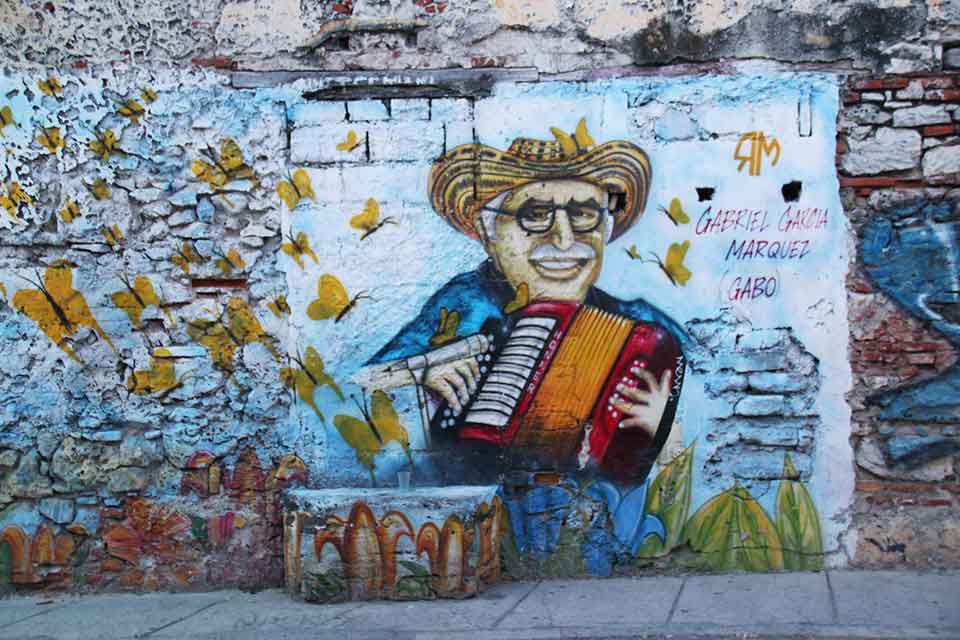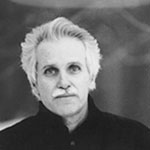As Popular as a Soccer Star

In Colombia, the popularity of Gabriel García Márquez rivals that of the country’s most famous soccer players. Could one imagine a better tribute to the value of literature itself?
I learned something pretty important, I’d say, about Gabriel García Márquez when I was in Colombia a few summers ago. Actually, it hit me almost as soon as I arrived in Cartagena, then was reinforced just about everywhere I traveled in the country.
You see, I’d more or less abandoned everything at home for a couple of weeks and decided, impromptu, on the trip. The idea was to immerse myself in the work and maybe the world of a writer for whom I never lose admiration, the author of—among many other books—the groundbreaking One Hundred Years of Solitude, of course, and the international best-seller Love in the Time of Cholera. (The latter garnered a wide general readership seldom seen with very literary novels and was adapted as a major movie, granting that in this case the product was a prime example of a Hollywoodized, over-the-top misinterpretation.) Also, there’s the novel not as well known as those others but what remains for me his highest achievement, The Autumn of the Patriarch. Telling of a mythical Latin American dictator who lives to be “somewhere between 107 and 232 years old,” hauntingly dreamlike and innovative in language and overall structure, it’s literature that I’d personally put right up there with anything turned out anywhere, worldwide, in the past century.
I made a reservation online for a hotel just outside Cartagena’s historic district, the Old City. I packed into a small gym bag some García Márquez paperbacks to reread and a half-dozen photocopied articles about the master’s work along with a few changes of clothes.
Enclosed by ancient golden-stone fortress walls there on the blue Caribbean, the Old City remains a quarter of narrow cobbled streets and pastel houses with terra-cotta roofs and wooden balconies dripping flowering vines, plus no shortage of elegantly baroque domed churches. Cartagena has been designated the most perfectly preserved sixteenth-century Spanish colonial city in the world, and to see it is to fully believe it, beyond lovely. But lately it’s also become a major tourist attraction, a sudden hot-spot destination now that the Colombian government has loudly announced that the twin violent dangers outsiders once freely associated with the country are gone, though in truth only to a degree: the terrorism of the FARC rebels in the mountains with their notorious kidnappings, and the rampant drug trade once thriving under perhaps the ultimate cartel boss, Pablo Escobar. I was glad I’d done my research ahead of time and avoided staying in the tourist-packed Old City proper. The place I’d booked, the Hotel Stil, was a scruffy yet quite comfortable tropical high-rise, probably from the 1980s, that catered chiefly to Colombians, located in a commercial pocket close enough to the Old City to allow for convenient exploration of the many places there associated with the author and his books. Love in the Time of Cholera is almost entirely set in the Old City, in a way García Márquez’s lyrical prose valentine to it, and the Old City did figure significantly in García Márquez’s own life.
He came of age in Cartagena as a young journalist in the 1940s, hanging out in cantinas with bohemian literary pals and soon becoming a featured columnist for the newspaper El Universal, headquartered in the Old City. He went on to live in Europe and then Mexico most of his adult life, but when he decided to build what amounted to a dream home in his later years, a sprawling, pale-apricot modernistic villa shaded by tall palms and overlooking the sea, it was Cartagena’s Old City he chose; he spent some winters there but sadly, due to ill health, never did get to use the house very much.
The young guy named Javier working the reception desk at the Hotel Stil was as tall and solid as an NFL linebacker, of African descent and very soft-voiced. There in the open-front lobby, mosquitoes whining around us, we tried together to figure out why the online booking site had the price messed up, overcharging me. I eventually assured a gently smiling Javier in Spanish that it was no major deal. I mean, at twenty-seven dollars a night with breakfast included (which turned out to be a fine spread of good Colombian coffee, local arepa corn flatbread, and piles of delicious fresh fruit), I saw no reason to try to question the difference of a couple of bucks. I asked for a room high up with some sort of a view, and I followed Javier carrying my bag into the creaky red-doored elevator to the very top floor, the tenth.
In the dim corridor he fiddled with the tricky lock, and I looked at what was an admittedly hokey framed wall mural. Rendered in lurid acrylics, it was a blown-up takeoff on the often reproduced head-and-shoulders photograph of Garcia Márquez—curly-topped, mustached, a wide toothy grin, and wearing his trademark black-and-white houndstooth jacket—offering the middle finger to maybe reporters, jokingly irreverent, as was his style throughout life. While Javier continued to have trouble with the lock—true, the Hotel Stil had seen much better days, but that was okay—I tipped my head to the mural, simply saying to Javier:
“García Márquez.”
Javier stopped what he was doing, his hands on the doorknob; standing there in his white hotel staff tunic with frayed red epaulettes, he looked right at me. Suddenly he seemed very serious, nodding his head.
“Sí, García Márquez, el gran hombre.”
The great man.
He spoke the words with obvious admiration, bordering on reverence.
I suppose I might have seen it as a good sign that, with the mural being there, I was in a way greeted by García Márquez upon my arrival (middle finger notwithstanding), but more importantly it was with Javier that I first learned what I would learn repeatedly during my time in Colombia, the pride that so many in the country—sometimes it felt like virtually everybody—appeared to take in their beloved author.
I might have seen it as a good sign that, with the mural being there, I was in a way greeted by García Márquez upon my arrival (middle finger notwithstanding).
Yes, during my stay I got responses similar to Javier’s, and not just from Colombians one might expect. Meaning, it wasn’t simply the pleasant salespeople in bookshops I spoke to at length or a friendly, very knowledgeable librarian I chatted with for a full couple of hours up the coast in Santa Marta, a jumping-off spot for my travel by rattling bus inland over lumpy emerald mountains and deep into the old United Fruit Company’s banana-plantation country to my ultimate target on the trip, Aracataca; the small rural town was García Márquez’s hometown, raised there by grandparents, and it also provided the model for the very magically real Macondo in One Hundred Years of Solitude.
But surprisingly, I also experienced similar responses to the mention of García Márquez from everyday people, those probably with little literary inclinations otherwise. This might entail anybody from cab drivers of the little yellow Hyundai Accent taxis that seem ubiquitous throughout Colombia to two locals I struck up a conversation with while having a late-afternoon beer in a Santa Marta bar, one a retired postman and the other a guy who did general handyman work. Perhaps they had only read a short story or two of García Márquez in school or perhaps never read him whatsoever, but I told myself here at last was a country where a writer—and a supremely literary one at that—seemed as popular as a soccer star, which is the usual sort of personage eliciting such utter reverence in much of the world. (Movie and pop-music celebrities, though admired, usually aren’t associated with reverence.) And in Colombia especially, for anybody to be even somewhat as popular as a soccer star is saying something. During my stay, the country had seemingly all but repressed the idea of work and normal commerce and was enjoying an ongoing unofficial holiday, noisy and celebratory, now that Colombia was steadily advancing in the World Cup competition underway in Brazil. The yellow, blue, and red national team jerseys could have been mandatory street attire; sidewalk vendors were surely having a profitable go of it peddling those annoying, atonal long plastic trumpets that I personally call hooligan horns as well as plastic replicas of the World Cup itself plated with cheesy gold finish, which aficionados wishfully pumped above their heads in imagined ultimate triumph, really funny.
Here at last was a country where a writer—and a supremely literary one at that—seemed as popular as a soccer star.
I mean, to put it in perspective—how odd it might be for most every cab driver in the U.S. to know the name Saul Bellow or Toni Morrison, two Americans who received their own Nobel Prizes in literature around the same time as García Márquez. Or, to get more specific, think of the orange-mugged, egg-beater-haired president of the U.S. then in 2018, noisily oafish, even knowing much about Saul Bellow or Toni Morrison in the first place, and you get the idea.
I do know from other travel experience that broad respect might be assigned to famous writers of the more distant past. In Dublin everybody seems to want to talk about Joyce, and in Paris there are still always postcards on racks at neighborhood news kiosks, where, among those showing the standard treasured landmarks of the Eiffel Tower or the Moulin Rouge, you’ll frequently see others with reproductions of old daguerreotypes of major literary figures in France’s long and storied literary history, national landmarks in their own right—Balzac or Baudelaire, let’s say. Nevertheless, I suspect such widespread popular adulation for a more contemporary writer like García Márquez must be rather rare in the world.
Actually, to return to that apt soccer analogy, often just to mention García Márquez’s name was to have a Colombian citizen go into some extended commentary about him with an anecdote or two and the writer usually referred to by his nickname among family and good friends, “Gabo,” which several Colombians I met tended to use. Even that was indicative, the variety of appellation otherwise reserved perhaps only for the country’s most lionized soccer heroes, those who can wield their own such intimately identifying tags. Which would have to include the most famous of them all in Colombia, Carlos Valderrama; known affectionately as “El Pibe” (The Kid), he was a true terror of the soccer pitch internationally in the 1980s and always easily identifiable by his wild tuft of dyed-blond hair before any soccer players dyed their hair, more or less a Harpo Marx halo.
So, I say forget about having another library named after you or typical stodgy statue erected by a municipality, the common modes of honoring a nation’s major authors. What better tribute to a writer and subsequently to the whole idea of literature itself can there be than to have an established popularity as decidedly widespread as, yes, that of a soccer star?
You know, thinking more about this now, I realize the trip did provide the good break I’d been looking for from work on my own fiction, which I can admit had hit a somewhat discouraging snag before I set out, a very slow and unproductive stretch at the laptop keyboard. And, to be honest, the attitude alone concerning García Márquez in Colombia was enough to thoroughly recharge me when I returned to my own writing. In a way, it also reinforced an important belief in the power of literature and the written word as found in great works, something that, sadly enough, seems to be increasingly pushed farther and farther aside in this loud and often quite vacuous electronic age.
Austin, Texas









